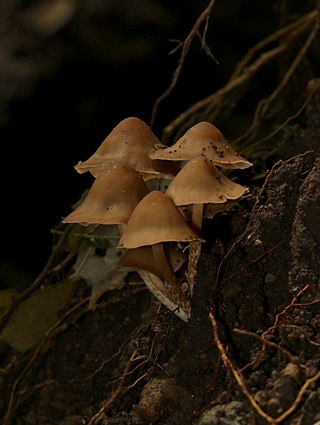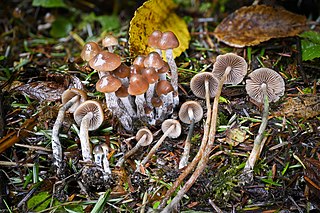
Psilocybe is a genus of gilled mushrooms, growing worldwide, in the family Hymenogastraceae. Most or nearly all species contain the psychedelic compounds psilocybin and psilocin.

Psilocybe cyanescens, commonly known as the wavy cap or potent psilocybe, is a species of potent psychedelic mushroom. The main compounds responsible for its psychedelic effects are psilocybin and psilocin. It belongs to the family Hymenogastraceae. A formal description of the species was published by Elsie Wakefield in 1946 in the Transactions of the British Mycological Society, based on a specimen she had recently collected at Kew Gardens. She had begun collecting the species as early as 1910. The mushroom is not generally regarded as being physically dangerous to adults. Since all the psychoactive compounds in P. cyanescens are water-soluble, the fruiting bodies can be rendered non-psychoactive through parboiling, allowing their culinary use. However, since most people find them overly bitter and they are too small to have great nutritive value, this is not frequently done.

Psilocybe tampanensis is a very rare psychedelic mushroom in the family Hymenogastraceae. Originally collected in the wild in a sandy meadow near Tampa, Florida, in 1977, the fungus would not be found in Florida again until 44 years later. The original Florida specimen was cloned, and descendants remain in wide circulation. The fruit bodies (mushrooms) produced by the fungus are yellowish-brown in color with convex to conic caps up to 2.4 cm (0.9 in) in diameter atop a thin stem up to 6 cm (2.4 in) long. Psilocybe tampanensis forms psychoactive truffle-like sclerotia that are known and sold under the nickname "philosopher's stones". The fruit bodies and sclerotia are consumed by some for recreational or entheogenic purposes. In nature, sclerotia are produced by the fungus as a rare form of protection from wildfires and other natural disasters.

Psilocybe azurescens is a species of psychedelic mushroom whose main active compounds are psilocybin and psilocin. It is among the most potent of the tryptamine-bearing mushrooms, containing up to 1.8% psilocybin, 0.5% psilocin, and 0.4% baeocystin by dry weight, averaging to about 1.1% psilocybin and 0.15% psilocin. It belongs to the family Hymenogastraceae in the order Agaricales.

The Strophariaceae are a family of fungi in the order Agaricales. Under an older classification, the family covered 18 genera and 1316 species. The species of Strophariaceae have red-brown to dark brown spore prints, while the spores themselves are smooth and have an apical germ pore. These agarics are also characterized by having a cutis-type pileipellis. Ecologically, all species in this group are saprotrophs, growing on various kinds of decaying organic matter. The family was circumscribed in 1946 by mycologists Rolf Singer and Alexander H. Smith.
Gastón Guzmán Huerta, a Mexican mycologist and anthropologist, was an authority on the genus Psilocybe.

Psilocybe banderillensis is a species of psilocybin mushroom in the family Hymenogastraceae known from the states of Veracruz and Oaxaca in Mexico. It is in the Psilocybe fagicola complex with Psilocybe fagicola, Psilocybe oaxacana, Psilocybe columbiana, Psilocybe herrerae, Psilocybe keralensis, Psilocybe neoxalapensis, and Psilocybe teofiloi.
Psilocybe columbiana is a species of mushroom in the family Hymenogastraceae known only from the páramos of high mountains in Colombia. It is in the Psilocybe fagicola complex with Psilocybe fagicola, Psilocybe oaxacana, Psilocybe banderillensis, Psilocybe herrerae, Psilocybe keralensis, Psilocybe neoxalapensis, and Psilocybe teofiloi.

Psilocybe fagicola is a species of psychedelic mushroom in the family Hymenogastraceae native to Mexico. The type specimen for the species was collected in 1959 in a beech forest in Hidalgo, Mexico.
Psilocybe herrerae is a species of psilocybin mushroom in the family Hymenogastraceae. The mushroom was first described by Mexican mycologist Gastón Guzmán. It contains the compounds psilocybin and psilocin. Psilocybe herrerae is known only from the states of Chiapas and Veracruz, Mexico. It is in the Psilocybe fagicola complex with Psilocybe fagicola, Psilocybe oaxacana, Psilocybe banderillensis, Psilocybe columbiana, Psilocybe keralensis, Psilocybe neoxalapensis, and Psilocybe teofiloi.

Psilocybe moseri is a species of mushroom in the family Hymenogastraceae. The mushroom contains the medicinal compound psilocybin. It is in the section Zapotecorum of the genus Psilocybe, other members of this section include Psilocybe muliercula, Psilocybe angustipleurocystidiata, Psilocybe aucklandii, Psilocybe collybioides, Psilocybe kumaenorum, Psilocybe zapotecorum, Psilocybe kumaenorum, Psilocybe subcaerulipes, Psilocybe pintonii, Psilocybe zapotecoantillarum, Psilocybe zapotecocaribaea, and Psilocybe antioquiensis.
Psilocybe zapotecoantillarum is a species of mushroom in the family Hymenogastraceae. The mushroom contains the medicinal compound psilocybin. It is in the section Zapotecorum of the genus Psilocybe, other members of this section include Psilocybe muliercula, Psilocybe angustipleurocystidiata, Psilocybe aucklandii, Psilocybe collybioides, Psilocybe kumaenorum, Psilocybe zapotecorum, Psilocybe kumaenorum, Psilocybe subcaerulipes, Psilocybe pintonii, Psilocybe moseri, Psilocybe zapotecocaribaea, and Psilocybe antioquiensis.

Psilocybe pelliculosa is a species of fungus in the family Hymenogastraceae. The fruit bodies, or mushrooms, have a conical brownish cap up to 2 cm in diameter atop a slender stem up to 8 cm long. It has a white partial veil that does not leave a ring on the stem. American mycologist Alexander H. Smith first described the species in 1937 as a member of the genus known today as Psathyrella; it was transferred to Psilocybe by Rolf Singer in 1958.

Psilocybe neoxalapensis is a species of psilocybin mushroom in the family Hymenogastraceae. Found in Veracruz, Mexico, it was originally described in 2005 under the name Psilocybe novoxalapensis, but this naming was later determined to be invalid, and it was renamed P. neoxalapensis in 2009. It is in the Psilocybe fagicola complex with Psilocybe fagicola, Psilocybe oaxacana, Psilocybe banderillensis, Psilocybe columbiana, Psilocybe keralensis, Psilocybe herrerae, and Psilocybe teofiloi.

Psilocybe allenii is a species of agaric fungus in the family Hymenogastraceae. Described as new to science in 2012, it is named after John W. Allen, who provided the type collection. It is found in the northwestern North America from British Columbia, Canada to Los Angeles, California, most commonly within 10 miles (16 km) of the Pacific coast.

Psilocybe medullosa is a species of psychoactive mushroom. It was originally described in 1898 as Naucoria medullosa by Italian mycologist Giacomo Bresadola. Czech mycologist Jan Borovička transferred it to Psilocybe in 2007. A widespread but rather rare species, it is found in Europe, where it grows as a saprobe on woody debris and detritus. Chemical analysis has been used to confirm the presence of the psychedelic compounds psilocin and psilocybin in the fruit bodies but probably at low levels. Psilocybe silvatica is its American sister species; it differs by subtle changes in molecular markers.

Psilocybe fuscofulva is a species of mushroom in that grows on Sphagnum moss and rarely decaying wood in peat bogs in North America and Europe. It is the only species of Psilocybe currently known to not produce psilocybin or psilocin. The phylogenetic placement indicates its close relationship to Psilocybe silvatica and Psilocybe semilanceata. It was previously most commonly known as Psilocybe atrobrunnea but the holotype does not exist and the neotype of this species was lost, so Psilocybe fuscofulva, which was previously regarded as a synonym but has a holotype, was resurrected to replace it.
Psilocybe keralensis is a species of psilocybin mushroom in the family Hymenogastraceae. It contains the compounds psilocybin and psilocin. Psilocybe keralensis is known only from Kerala, India. It is in the Psilocybe fagicola complex with Psilocybe fagicola, Psilocybe oaxacana, Psilocybe banderillensis, Psilocybe columbiana, Psilocybe herrerae, Psilocybe neoxalapensis, and Psilocybe teofiloi.












